|
|

After two tail wheel spring failures, I decided to figure out how to use a compression spring as a tail wheel spring. I checked out clevis springs, but they were too large and heavy for the FireFly. The photo above shows the replacement system. It is made of a bicycle wheel spoke, a precision die spring, a brass spacer and a brass ball. The brass ball diameter is 5/16th of an inch. Half of the ball was filed away and a hole was drilled in the center of the flat so the threaded end of the spoke could pass through. The spring was selected so that it would slip over the spoke nut. The outside round part of the ball is a bearing surface that makes contact with the tail wheel control arm while the hole through the ball is the bearing surface for the spoke. The flat surface of the ball seats one end of the compression spring. The new system shown above shows a weight savings of 0.6 oz per side. |
 The back side of the tail wheel control arm tube was cut away. Another 0.6 oz was saved. This is necessary because clearance is required for the half ball, spring, spoke and nut on the back side. A 5/16 inch diameter drill bit was used to make a bearing surface for the ball.
The back side of the tail wheel control arm tube was cut away. Another 0.6 oz was saved. This is necessary because clearance is required for the half ball, spring, spoke and nut on the back side. A 5/16 inch diameter drill bit was used to make a bearing surface for the ball.
The red arrow points to the groove worn into the metal by the original spring hook. With this new system, all high loads are transfered through a bearing material or a non moving contact surface. |
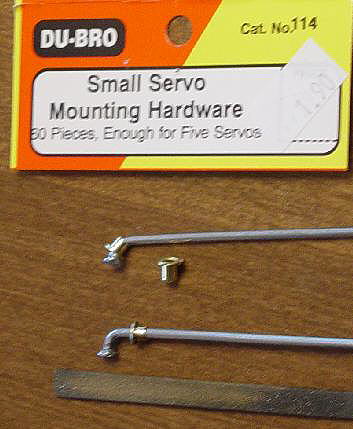 To prevent steel on steel at the rudder control arm, the control arm spring holes were drilled out to 1/8th of and inch ID and short flanged brass spacers were inserted into the holes. As shown to the left, the non flange end of the spacer was filed away until it could be slipped on to the spoke. Also the swage line on the spoke head was filed away to provide a smooth bearing surface to the brass flange.
To prevent steel on steel at the rudder control arm, the control arm spring holes were drilled out to 1/8th of and inch ID and short flanged brass spacers were inserted into the holes. As shown to the left, the non flange end of the spacer was filed away until it could be slipped on to the spoke. Also the swage line on the spoke head was filed away to provide a smooth bearing surface to the brass flange.
|
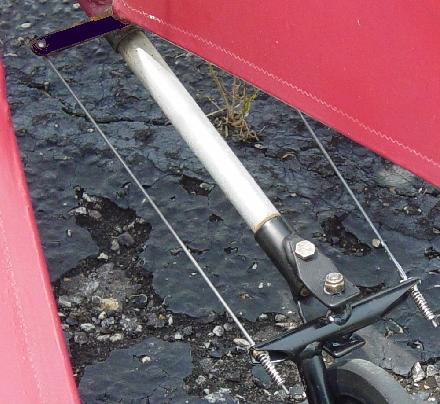 Using a small round file, the holes that the spokes passed through were wallowed out from side to side on the front side of the control arm. This has to be done so that the spokes will not bind in the hole when the rudder is at either stop. The springs were tightened to the point that they were almost completely compressed when the rudder was hard over against the stop. This makes for very positive rudder pedal input. One can make much tighter turns than with the original chain and tension spring system.
Using a small round file, the holes that the spokes passed through were wallowed out from side to side on the front side of the control arm. This has to be done so that the spokes will not bind in the hole when the rudder is at either stop. The springs were tightened to the point that they were almost completely compressed when the rudder was hard over against the stop. This makes for very positive rudder pedal input. One can make much tighter turns than with the original chain and tension spring system.
Lubrication is easy as a dab of soft grease on top of spoke ends on the rudder control arm and an additional dab on each ball at the end of the tail wheel control arm. |
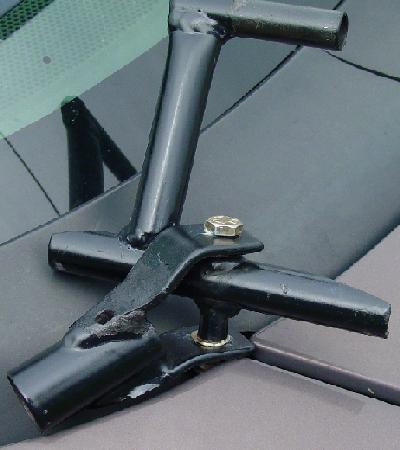 The tail wheel pivot hinge was very loose. Again it is a problem of steel on steel. I used a new drill and drilled all original 1/4 inch diameter holes out to 9/32. Then I inserted brass tubing into all the bores. Also, I added a brass washer as a thrust bearing. I used a new bolt and after greasing and assembly there was no significant play in the pivot.
The tail wheel pivot hinge was very loose. Again it is a problem of steel on steel. I used a new drill and drilled all original 1/4 inch diameter holes out to 9/32. Then I inserted brass tubing into all the bores. Also, I added a brass washer as a thrust bearing. I used a new bolt and after greasing and assembly there was no significant play in the pivot.
So, how does it perform? For the first flight, there were no problems upon taxi out and take off. In a slight cross wind landing, I had to dance a little on the rudder pedals. This showed that the neutral position spring preloading was too light. I had used a 1" long, 0.24" OD, 0.032" wire diameter stainless steel spring. I replaced it with an identical zinc electro-coated music wire spring which is 20% stronger. A second flight proved this spring to be much better. Finally, I settled on a 1-1/2" long, .24" OD, .038" diameter zinc plated music wire spring. With the higher preloading, the FireFly does not wander, and the tail wheel is much more responsive to pedal input. With this set up, smaller radius turns can be made in grass. The brass balls and compression springs were purchased from McMaster-Carr. The bicycle spokes were purchased from a local bicycle shop. The brass tubing and spacers were purchased at a model/hobby shop. |
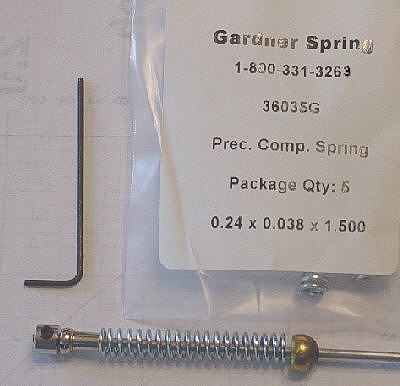 The tail wheel assembly takes a beating, and spoke lock nuts were dropping off. Lock nuts were replaced with a locking collar. A set screw prevents the collar from rotating or slipping on the spoke. The collar is snugged up to the spoke nut and the set screw tightened.
The tail wheel assembly takes a beating, and spoke lock nuts were dropping off. Lock nuts were replaced with a locking collar. A set screw prevents the collar from rotating or slipping on the spoke. The collar is snugged up to the spoke nut and the set screw tightened.
|
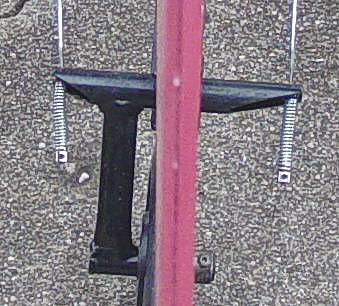 Here is the assembled view. The spoke nut threads take all the spring loads. The collars prevent the spoke nuts from backing off the spoke.
Here is the assembled view. The spoke nut threads take all the spring loads. The collars prevent the spoke nuts from backing off the spoke.
The collars can be found at most hobby shops. |